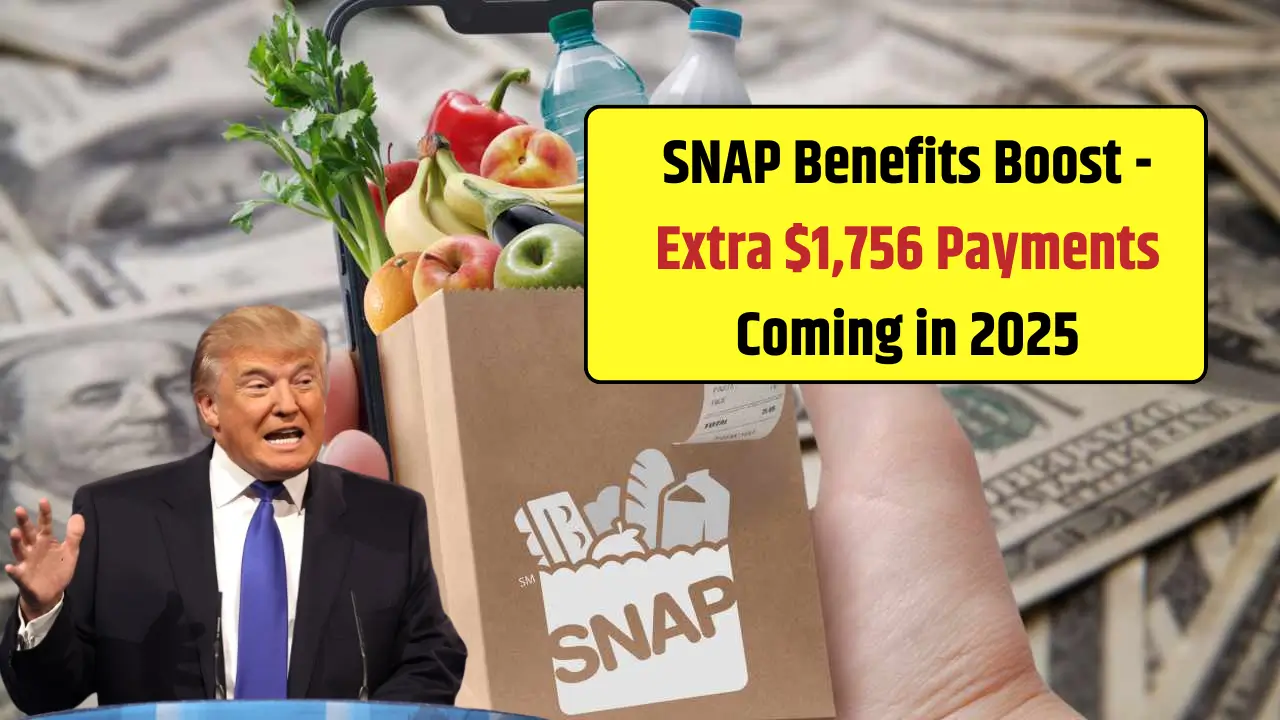SNAP Extra $1,756 Payments: The Supplemental Nutrition Assistance Program (SNAP) Benefits Boost: Extra $1,756 Payments Confirmed for 2025 is a significant development for millions of low-income families across the United States.
As food prices and living costs continue to rise, the US Department of Agriculture (USDA) and federal government have stepped up to increase the SNAP allotments to better support vulnerable households. This boost in benefits reflects the government’s commitment to addressing food insecurity and improving nutrition among economically disadvantaged populations.
The new provisions, effective from July 2025, stem from the One Big Beautiful Bill Act of 2025 (OBBB), signed into law on July 4, 2025. This legislation has reshaped how SNAP benefits are calculated, updated eligibility thresholds, and adjusted payment scales based on the latest cost-of-living data.
The $1,756 figure refers to the cumulative additional payments a qualifying household might receive over a year, depending on its size and circumstances. This article breaks down the changes in detail, explains who qualifies, how benefits are allocated, and what this boost means for recipients.
Understanding the SNAP Benefits Increase in 2025
SNAP benefits are calculated using a baseline called the Thrifty Food Plan (TFP), which estimates the cost of nutritious, low-cost meals for families of different sizes. In 2025, the USDA updated this plan following a mandated re-evaluation, acknowledging a substantial rise in the prices of essential food items such as fruits, vegetables, dairy, and protein.
As a result, the maximum monthly SNAP allotments saw an increase of approximately 12-15%, translating into an additional $1,756 annually for many households, especially larger families.
This means, for example, that an eight-person household could receive up to $1,751 monthly — the highest payment level in SNAP history. The increase is designed to help families offset inflationary pressures and maintain adequate nutritional intakes.
Eligibility Criteria and Adjustments
The eligibility for SNAP has also been revised to include more families who were previously marginal or ineligible. Income caps for both gross and net earnings are increased, and asset limits have been updated to reflect real economic circumstances. Key eligibility updates for 2025 include:
- Gross income limit is generally set at 130% of the federal poverty line. For a household of four, this means qualifying if gross monthly income is less than approximately $3,000.
- Net income limits are also adjusted to allow more households to qualify, now at $2,600 per month for a family of four.
- Certain deductions for shelter costs, medical expenses, and childcare are factored into income calculations.
- Work requirements for able-bodied adults without dependents (ABAWD) have been modified with new exemptions.
Such adjustments ensure a broader swath of vulnerable Americans can access food assistance programs to improve their quality of life.
Breakdown of SNAP Maximum Monthly Allotments 2025
| Household Size | Maximum Monthly SNAP Payment (USD) |
| 1 | $291 |
| 2 | $535 |
| 3 | $766 |
| 4 | $973 |
| 5 | $1,155 |
| 6 | $1,386 |
| 7 | $1,532 |
| 8 | $1,751 |
| Each Additional Person | +$219 |
These monthly payments represent a substantial increase compared to previous years, providing families with more resources to afford healthy food items.
Impact of SNAP Benefits Boost on Families and Communities
The SNAP benefits increase brings several positive outcomes:
- Enhanced nutritional security for families, reducing childhood hunger.
- More disposable income that can be redirected to rent, utilities, and healthcare.
- Support for local economies as SNAP dollars are spent at grocery stores and markets.
- Greater access to fresh produce and high-quality food, promoting better health outcomes.
Research consistently shows that increased SNAP benefits correlate with reductions in food insecurity and improvements in overall family wellbeing.
How and When SNAP Benefits Are Distributed
SNAP benefits are distributed monthly on Electronic Benefits Transfer (EBT) cards, similar to debit cards. Each state manages its distribution schedule based on case numbers or Social Security numbers. Payments usually occur from the 1st to the 20th of each month, allowing beneficiaries to plan their grocery shopping accordingly.
Beneficiaries should check with their state’s Department of Human Services website or SNAP portals to understand specific payment dates and amounts.
Additional Support & Programs Available
Besides the standard SNAP benefits, recipients may also be eligible for additional nutrition education, farmers market incentives, or summer meal programs for children. Some states have adopted complementary benefits like Double Up Food Bucks, which increases purchasing power for fresh fruits and vegetables.
Recipients are encouraged to take advantage of these programs, maximizing the benefits and improving dietary outcomes.
Conclusion
The confirmed SNAP Benefits Boost in 2025, including up to $1,756 in extra annual payments, represents a critical step in addressing food insecurity and supporting millions of American families facing economic challenges.
These increased benefits, alongside adjusted eligibility standards, reflect the government’s commitment to ensuring that nutritious food is accessible to all irrespective of income. Staying informed about program updates and understanding payment schedules can help families better navigate and benefit from SNAP assistance throughout the year.
Frequently Asked Questions (FAQs)
Q1: What is the maximum SNAP benefit amount in 2025?
A: For an eight-person household, the max monthly payment is $1,751, with increments for additional members.
Q2: Who qualifies for the SNAP benefits increase in 2025?
A: Eligible low-income households meeting income and asset thresholds, including new thresholds introduced in 2025.
Q3: How are SNAP benefits distributed?
A: Payments are made monthly via EBT cards, with schedules varying by state.
Q4: What is the reason for the SNAP benefits increase in 2025?
A: Adjustments are based on the updated Thrifty Food Plan, reflecting inflation and rising food prices.
Q5: Are there additional programs alongside SNAP benefits available?
A: Yes, programs like nutrition education, farmers market incentives, and Double Up Food Bucks help maximize benefits.






